

Original Article - Year 2015 - Volume 30 -
Surgical treatment of 510 patients with highly active antiretroviral therapy-associated lipodystrophy
Tratamento cirúrgico de 510 pacientes portadores de lipodistrofias secundárias ao uso de antirretrovirais
ABSTRACT
INTRODUCTION The treatment of acquired immunodeficiency syndrome has undergone important advances since the introduction of highly active antiretroviral therapy (HAART). This treatment led to the elimination of the virus in the bloodstream and increased survival; however, metabolic and structural changes became evident. One of these changes is lipodystrophy, the redistribution of body fat. With one of the largest samples worldwide, the aim of this work was to present some of the various surgical alternatives as well as the results obtained for minimizing the impact of lipodystrophy.
METHOD: From July 2005 to July 2013, 510 patients with HAART-associated lipodystrophy underwent surgery in the Clinic of Plastic Surgery, Heliópolis Hospital. All patients submitted to prior clinical and immunological assessments made with the aid of the infectious diseases team. The present study was approved by the Research Ethics Committee of the ABC Foundation.
RESULTS: The 510 patients included 335 women and 175 men with an age range of 16-74 years. Liposuction of the cervicodorsal fat pad (buffalo hump) was predominant (199 cases). With regard to the response stimulated through a subjective questionnaire, a high degree of satisfaction was observed with a significant increase in self-esteem and greater adherence to antiretroviral treatment.
CONCLUSION: The surgical correction of body lipodystrophy demonstrably improves the aesthetics of patients using HAART; however, its psychological and social effects are even more important since self-esteem increases and stigma decreases, which leads to better adherence to antiretroviral treatment.
Keywords: Lipodystrophy; HIV infections; Serodiagnosis of AIDS; Lipectomy; Body composition.
RESUMO
INTRODUÇÃO O tratamento da Síndrome da Imunodeficiência Adquirida vem sofrendo importantes avanços desde a introdução da terapia antirretroviral altamente ativa, conhecida como HAART (high active antirretroviral therapy). Este tratamento levou à eliminação do vírus na corrente sanguínea e ao aumento na sobrevida, entretanto alterações metabólicas e estruturais tornaram-se evidentes. Uma dessas alterações é a redistribuição de gordura corpórea, também denominada lipodistrofia. Com uma das maiores casuísticas mundiais, o objetivo deste trabalho é demonstrar algumas das alternativas cirúrgicas, bem como os resultados obtidos na tentativa de minimizar o impacto da lipodistrofia.
MÉTODO: No período de julho de 2005 a julho de 2013, 510 pacientes portadores de lipodistrofia secundária ao uso de HAART foram operados pela Clínica de Cirurgia Plástica do Hospital Heliópolis. Todos esses pacientes foram submetidos à prévia avaliação clínica e imunológica, sob auxílio da equipe de Infectologia. O presente trabalho foi aprovado pelo Comitê de Ética em Pesquisa da Fundação do ABC.
RESULTADO: Dentre os 510 pacientes, 335 eram do sexo feminino e 175 do sexo masculino, com idades variando entre 16 e 74 anos. Quanto aos procedimentos, destacou-se lipoaspiração da giba e dorso, com 199 casos. Quanto à resposta estimulada através de questionário subjetivo, observou-se elevado grau de satisfação, aumento significativo da autoestima e maior adesão ao tratamento antirretroviral.
CONCLUSÃO: A correção cirúrgica da lipodistrofia corporal comprovadamente melhora o aspecto estético do paciente que faz uso da HAART; porém, o efeito psicológico e social é ainda mais importante, elevando a autoestima, com diminuição dos estigmas, e proporcionando uma maior adesão ao tratamento antirretroviral.
Palavras-chave: Lipodistrofia; Infecções por HIV; Sorodiagnóstico da AIDS; Lipectomia; Composição corporal.
Acquired immunodeficiency syndrome (AIDS) has undergone major epidemiological and clinical changes, since its initial description in 1981, mainly because of the introduction of highly active antiretroviral therapy (HAART), in 1998. This new therapeutic arsenal was responsible for a significant reduction in morbidity and mortality of individuals infected with the human immunodeficiency virus (HIV), drastically changing the natural evolution of the disease observed to that point. This therapy led to a significant and sustained viral load reduction as well as improved quality of life and survival rates; however, metabolic and physical changes also occur that can lead to acquired body deformities that were otherwise irrelevant1-3.
Lipodystrophy, a change in body fat distribution, causes the accumulation of fat in the back, cervical, and intra-abdominal regions as well as a reduction in adipose tissue in other regions such as the face, limbs, and buttocks1.
To minimize the psychological and social consequences of lipodystrophy, pharmaceutical and surgical treatments have been proposed, the latter of which have proven more effective to date4.
OBJECTIVE
With one of the largest samples worldwide, this study presents some of the various surgical alternatives as well as the results obtained in an attempt to minimize the impact of HAART-associated lipodystrophy.
METHOD
All patients were studied according to the principles of the Declaration of Helsinki and the Nuremberg Code in compliance with the Standards for Research Involving Human Beings (Res. CNS 196/96) of the National Health Council after project approval was granted by the Heliópolis Hospital and the Committee for Ethics in Research of the Universidade Federal do ABC.
Retrospective and cohort study. From July 2005 to July 2013, 510 patients with HAART-associated lipodystrophy underwent surgery in the Plastic Surgery Clinic, Heliópolis Hospital. All patients underwent prior clinical and immunological evaluation with the assistance of the Infectious Diseases team of Heliópolis Hospital.
All patients were retrospectively evaluated. As part of the routine, all patients who underwent any surgical procedure signed the Free and Informed Consent statement (Appendix 1) for surgery, which included aspects regarding participation in scientific studies.
Any clinically balanced patient who was unhappy with his or her body image due to HAART-associated lipodystrophy for at least 12 months was included in this study. Clinical and/or immunologically decompensated patients were excluded and directed to the services of origin to be compensated. Immunologically, the patients needed to present with CD4 levels >350 cells/mm3, a viral load <10,000 copies/mL, and stability for 6 months in accordance with the Ministry of Health services5.
Surgical treatment was chosen in accordance with the clinical manifestations and the patient's main complaint. In certain cases, imaging methods such as computed tomography aided in the diagnosis and surgical planning process.
The correction of facial atrophy was performed with polymethylmethacrylate (Metacrill®)-based filling. This treatment was not considered surgical; therefore, it was not the objective of this study.
Lipoaccumulation was treated mainly with the manual assisted liposuction technique using a vacuum liposuction aspirator or vibro-assisted liposuction since the fat is thicker than that in non-infected individuals, especially in the dorsal region (cervicodorsal and lumbodorsal regions). It was occasionally necessary to resect the excess skin, mainly in the abdomen and arms (Figure 1).
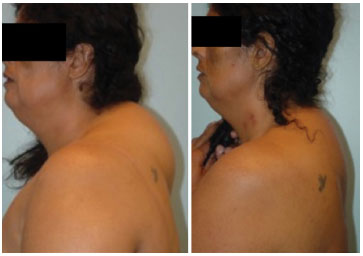
Figure 1. E.P., a 54-year-old woman. Pre- and post-operative liposuction of the cervicodorsal fat pad.
In cases of abdominal lipodystrophy with significant adipose accumulation (Figure 2), abdominal dermolipectomy was indicated and generally associated with liposuction of the upper portion of the abdomen according to the techniques of Callia6 and Saldanha et al.7. A computed tomography scan of the abdomen was performed to exclude intra-abdominal lipoaccumulation; in such cases, surgery was not indicated because the result would be unsatisfactory.
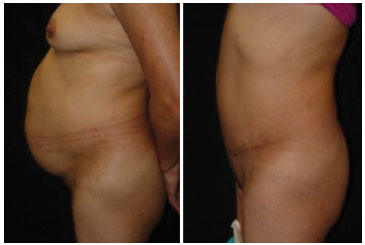
Figure 2. A.R.S., a 43-year-old woman. Pre- and post-operative dermolipectomy with abdominal liposuction.
The correction of buttock hypotrophy was accomplished using specific prostheses for the region provided by Silimed devices (®) using the XYZ of Gonzalez technique (Figure 3). In some cases, with less hypotrophy, liposuction of the back and flank was indicated along with fat grafting in the buttocks8,9.
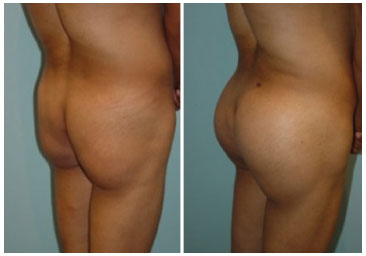
Figure 3. A.A.O., a 38-year-old woman. Pre- and post-operative view of the buttocks (including an implant).
Surgical corrections involving the face and cervical region were performed with techniques used in the middle and lower thirds of facial lifting and resection of the excess pre- and infra-auricular skin with ladder plication of the superficial musculoaponeurotic system (Figure 4). Special attention was given to the lower cervical region, in which fat accumulation and accentuated flaccidity were important patient complaints. The correction in this region was performed with liposuction, followed by median platysmal plication10.
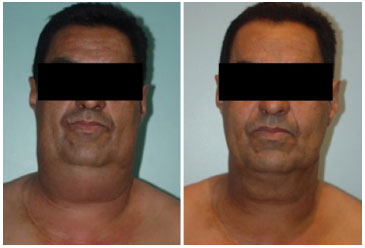
Figure 4. A. M. S., a XX-year-old man. Pre and post-operative liposuction of the chin associated with a facelift of the middle and lower thirds of the face.
A questionnaire was used (Appendix 2) with each patient to quantify the degree of satisfaction with therapy.
RESULTS
Among the 510 patients evaluated, 335 were women and 175 were men 16-74 years of age (Table 1). Liposuction of the cervicodorsal fat pad (buffalo hump) was predominant (199 cases), followed by the inclusion of gluteal prosthesis (88 cases) and abdominal dermolipectomy (60 cases) (Table 2).
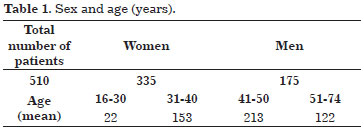
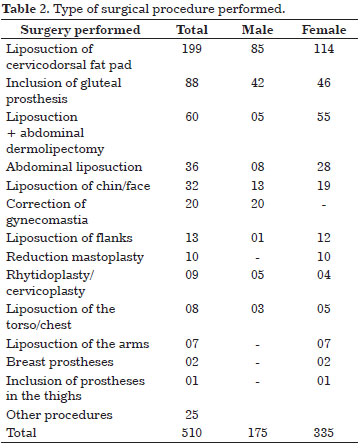
Regarding the response obtained through a subjective questionnaire (Appendix 2), we observed a high degree of satisfaction with the results obtained with the surgeries as well as a significant increase in self-esteem and a greater adherence to antiretroviral treatment.
DISCUSSION
Although highly efficient, HAART plus HIV leading to the appearance of toxicity in the long term that was not previously observed has become one of the most important problems in the treatment of AIDS1,4.
Some of the changes found include impaired metabolism (hypertriglyceridemia, hypercholesterolemia, increased insulin resistance); increased cardiovascular risk; psychological and sexual disorders; kidney diseases; bone changes; and body lipodystrophy2,4.
The incidence of HAART-associated lipodystrophy is 25-50% but may reach 84%1.
The role of various drugs used in HAART in relation to the development of lipodystrophy is not yet fully clarified. Several studies indicate that nucleoside analogue reverse transcriptase inhibitors have a major role in the genesis of peripheral lipodystrophy, while the IPs act on the accumulation of visceral fat and the changes related to metabolic syndrome. More recent studies, however, have also demonstrated a correlation with lipodystrophy in patients using non-nucleoside reverse transcriptase inhibitors. HIV itself may also contribute to this syndrome1,4.
The main complaints were facial hypertrophy and the accumulation of fat in certain areas of the body, more frequently the cervicodorsal region, which causes the greatest stigma in patients and leads to greater social exclusion and lower self-esteem.
Liposuction alone was the most commonly performed procedure due to body lipoaccumulation. Compared to liposuction in uninfected patients, those with HIV exhibit quite dense fatty tissue, indicating a need for greater physical strength and, therefore, more caution in regions susceptible to injuries to internal organs. There is also the risk of residual lipoaccumulation due to technical difficulties in this procedure, which requires more surgical steps in addition to the inherent possibility of recurrence since the causal relationship is continuous (chronic use of antiretroviral therapy).
Regarding the complaint of gluteal hypotrophy, unfortunately only partial correction is possible. The techniques used (fat grafting and implant) aim to obtain functional improvement for clothing support (pants) and a more pronounced gluteal projection. However, it is not possible to improve the support and pressure on the ischial regions characterized by sitting. This report is more common in men and in cases of accentuated gluteus lipoatrophy. The layer of fat that protects the bony projections is very small or even non-existent in some cases.
Atrophy of the inner thighs can be corrected with fat grafts; however, as the deformities are accentuated and a portion of the fat is reabsorbed, this correction has unsatisfactory results. There was one case of implant placement in this location with an aesthetically favorable outcome.
In the treatment of the abdominal region, liposuction was performed with abdominal dermolipectomy. In the interim, it should be emphasized that patients with intra-abdominal fat accumulation diagnosed using computed tomography were excluded. Liposuction is necessary in the hypogastric regions and flanks for better body contour as well as abdominoplasty with median plicatures, although the diastasis of the abdominal rectus muscle is not the main cause of the deformity. Based on the patients' responses to the questionnaire, it was possible to observe that the acceptance of surgical treatment is high, while some underwent different procedures in different body regions.
It is not difficult to imagine that a disease that significantly changes one's body image affects an individual's personal and social life, leading to a higher rate of depression and anxiety than in those who are not affected by the syndrome. Because of these changes, these patients have a higher perception of body change, greater social isolation, and a lower level of satisfaction with antiretroviral treatment. This situation would lead to a reduction in adherence to the anti-HIV drug treatment. Thus, reconstructive plastic surgery in these subjects is used as mechanism among other benefits to aid in drug therapy maintenance.
CONCLUSION
The surgical correction of body lipodystrophy demonstrably improves the aesthetic appearance of patients on HAART; however, its psychological and social effects are even more important since they increase self-esteem, decrease stigma, and result in greater adherence to antiretroviral treatment.
ACKNOWLEDGMENTS
We thank the patients who consented to the reporting of their post-operative results and personal satisfaction. We are grateful for Heliópolis Hospital, which provided the infrastructure for our work. We thank Dr. Wilson Andreoni, regent of this service, for the stimulus to continue studying and acquire new knowledge. We emphasize that the work of our esteemed Secretary Rosana Brum is of fundamental importance since it makes our ambulatory procedures more organized and effective.
REFERENCES
1. Furtado JJD, Zambrini H, Jordão D NO, Scozzafave GA, Brasileiro RF. Ambulatório de lipodistrofia do Hospital Heliópolis: uma experiência com as correções cirúrgicas em dois anos de atendimento. Prát Hosp. 2007;58(28):28-32.
2. Nelson L, Stewart KJ. Psychological morbidity and facial volume in HIV lipodystrophy: quantification of treatment outcome. J Plast Reconstr Aesthet Surg. 2012;65(4):439-47. http://dx.doi.org/10.1016/j.bjps.2011.11.024. PMid:22153841.
3. Singhania R, Kotler DP. Lipodystrophy in HIV patients: its challenges and management approaches. HIV AIDS (Auckl). 2011;3:135-43. PMid:22267946.
4. Kosmiski L, Kuritzkes D, Hamilton J, Sharp T, Lichtenstien K, Hill J, et al. Fat distribution is altered in HIV-infected men without clinical evidence of the HIV lipodystrophy syndrome. HIV Med. 2003;4(3):235-40. http://dx.doi.org/10.1046/j.1468-1293.2003.00151.x. PMid:12859322.
5. Brasil. Ministério da Saúde. Portaria conjunta nº 2 de 27 de março de 2007. Anexo IV. Legislações conjunta. Diretrizes de indicação para tratamento de lipodistrofia em portadores HIV/Aids [Internet]. 2007 [acesso em 2014 Março 24]. Disponível em: http://www.brasilsus.com.br/legislacoes/conjuntas/9005-2.html
6. Callia WEP. Contribuição para o estudo da correção cirúrgica do abdome em pendulo e globoso: técnica original [Tese]. São Paulo: Universidade de São Paulo, Faculdade de Medicina; 1965.
7. Saldanha OR, De Souza Pinto EB, Mattos WN JR, Pazetti CE, Lopes Bello EM, Rojas Y, et al. Lipoabdominoplasty with selective and safe undermining. Aesthetic Plast Surg. 2003;27(4):322-7. http://dx.doi.org/10.1007/s00266-003-3016-z. PMid:15058559.
8. Gonzalez R. Augmentation gluteoplasty: the XYZ method. Aesthetic Plast Surg. 2004;28(6):417-25. http://dx.doi.org/10.1007/s00266-004-3130-6. PMid:15633021.
9. Gonzalez R. Buttocks reshaping: posterior contour surgery. A step-by-step approach. Rio de Janeiro: Indexa; 2006.
10. Stuzin JM. MOC-PSSM CME article: face lifting. Plast Reconstr Surg. 2008;121(1 Supl):1-19. http://dx.doi.org/10.1097/01.prs.0000294656.92618.2b. PMid:18182954.
1. Serviço de Cirurgia Plástica "Dr. Wilson Andreoni", São Paulo, SP, Brazil
2. Hospital Heliópolis, São Paulo, SP, Brazil
Institution: Study perfomed at the Hospital Heliópolis, São Paulo, SP, Brazil.
Corresponding author:
Geraldo Antonio Estanislau Scozzafave
Avenida Engenheiro Luís Gomes Cardim Sangirardi, 607
São Paulo, SP, Brazil Zip Code 04112-080
E-mail: scozza@uol.com.br
Article received: March 24, 2014.
Article accepted: December 13, 2014.


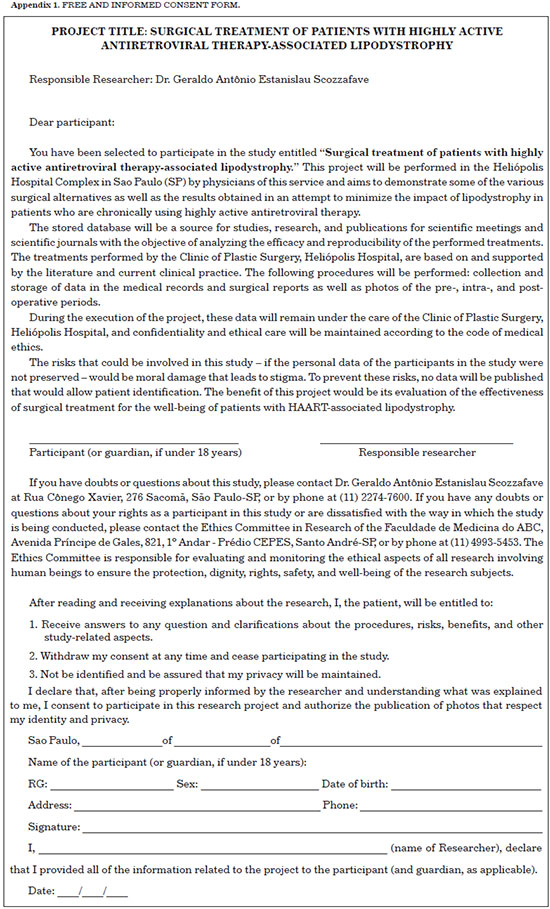

 Read in Portuguese
Read in Portuguese
 Read in English
Read in English
 PDF PT
PDF PT
 Print
Print
 Send this article by email
Send this article by email
 How to Cite
How to Cite
 Mendeley
Mendeley
 Pocket
Pocket
 Twitter
Twitter